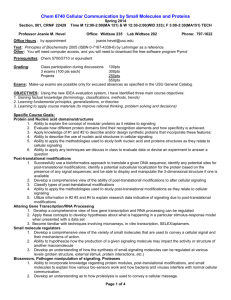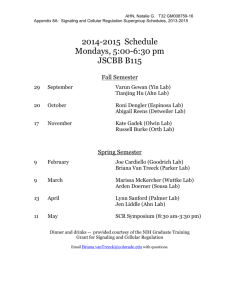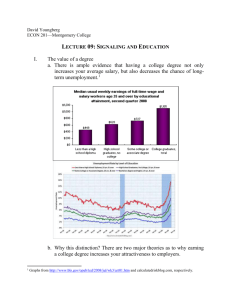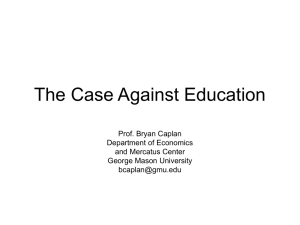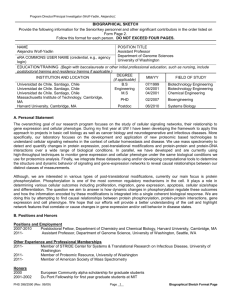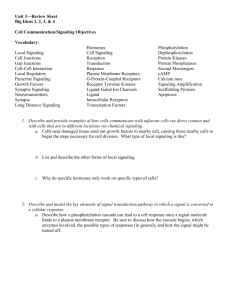CHEM 6740
advertisement
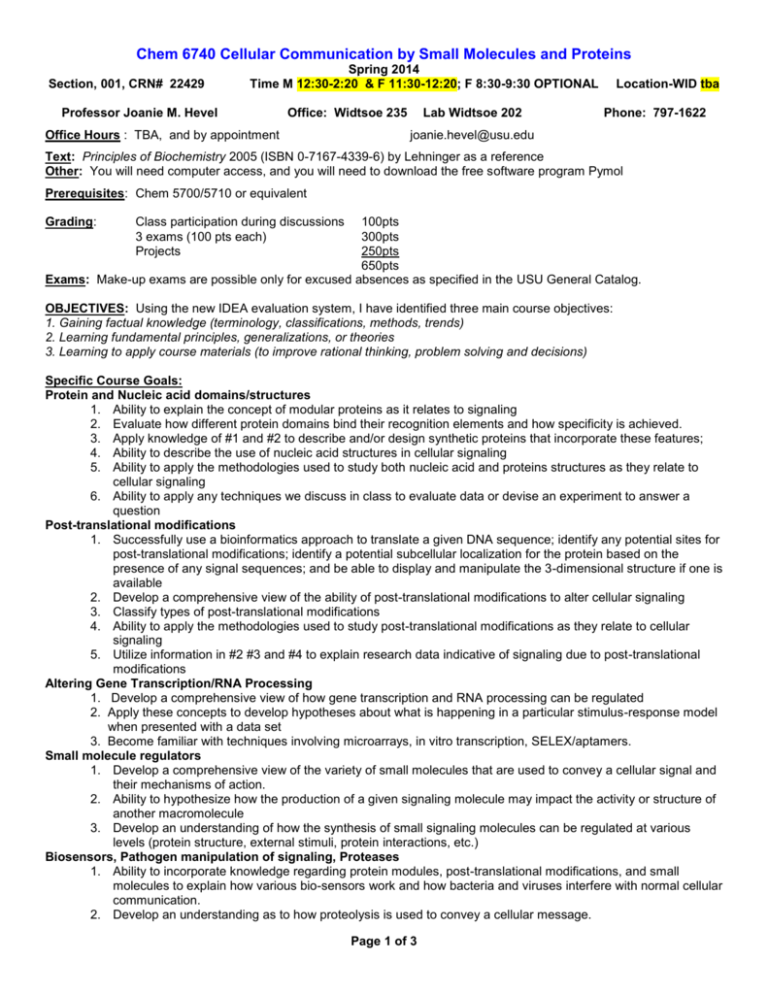
Chem 6740 Cellular Communication by Small Molecules and Proteins Section, 001, CRN# 22429 Spring 2014 Time M 12:30-2:20 & F 11:30-12:20; F 8:30-9:30 OPTIONAL Professor Joanie M. Hevel Office: Widtsoe 235 Office Hours : TBA, and by appointment Lab Widtsoe 202 Location-WID tba Phone: 797-1622 joanie.hevel@usu.edu Text: Principles of Biochemistry 2005 (ISBN 0-7167-4339-6) by Lehninger as a reference Other: You will need computer access, and you will need to download the free software program Pymol Prerequisites: Chem 5700/5710 or equivalent Grading: Class participation during discussions 3 exams (100 pts each) Projects 100pts 300pts 250pts 650pts Exams: Make-up exams are possible only for excused absences as specified in the USU General Catalog. OBJECTIVES: Using the new IDEA evaluation system, I have identified three main course objectives: 1. Gaining factual knowledge (terminology, classifications, methods, trends) 2. Learning fundamental principles, generalizations, or theories 3. Learning to apply course materials (to improve rational thinking, problem solving and decisions) Specific Course Goals: Protein and Nucleic acid domains/structures 1. Ability to explain the concept of modular proteins as it relates to signaling 2. Evaluate how different protein domains bind their recognition elements and how specificity is achieved. 3. Apply knowledge of #1 and #2 to describe and/or design synthetic proteins that incorporate these features; 4. Ability to describe the use of nucleic acid structures in cellular signaling 5. Ability to apply the methodologies used to study both nucleic acid and proteins structures as they relate to cellular signaling 6. Ability to apply any techniques we discuss in class to evaluate data or devise an experiment to answer a question Post-translational modifications 1. Successfully use a bioinformatics approach to translate a given DNA sequence; identify any potential sites for post-translational modifications; identify a potential subcellular localization for the protein based on the presence of any signal sequences; and be able to display and manipulate the 3-dimensional structure if one is available 2. Develop a comprehensive view of the ability of post-translational modifications to alter cellular signaling 3. Classify types of post-translational modifications 4. Ability to apply the methodologies used to study post-translational modifications as they relate to cellular signaling 5. Utilize information in #2 #3 and #4 to explain research data indicative of signaling due to post-translational modifications Altering Gene Transcription/RNA Processing 1. Develop a comprehensive view of how gene transcription and RNA processing can be regulated 2. Apply these concepts to develop hypotheses about what is happening in a particular stimulus-response model when presented with a data set 3. Become familiar with techniques involving microarrays, in vitro transcription, SELEX/aptamers. Small molecule regulators 1. Develop a comprehensive view of the variety of small molecules that are used to convey a cellular signal and their mechanisms of action. 2. Ability to hypothesize how the production of a given signaling molecule may impact the activity or structure of another macromolecule 3. Develop an understanding of how the synthesis of small signaling molecules can be regulated at various levels (protein structure, external stimuli, protein interactions, etc.) Biosensors, Pathogen manipulation of signaling, Proteases 1. Ability to incorporate knowledge regarding protein modules, post-translational modifications, and small molecules to explain how various bio-sensors work and how bacteria and viruses interfere with normal cellular communication. 2. Develop an understanding as to how proteolysis is used to convey a cellular message. Page 1 of 3 Projects Project #1-#3 (50 pt each, total 150 pts) Projects 1 through 3 are interrelated. I will provide you with a research problem and specific questions/hypotheses and you will be required (as a group) to design experiments that can answer/test these questions. You will need to show what your data would look like and what conclusions may be drawn. This is a chance to explore new technology/methodology that you may not have used previously and understand the limitations involved. At the end of Project #1, you will turn in the experimental design and results. For Project #2, I will give you what the “real results” looked like for project #1 (you may have been correct or incorrect, I am not grading you on how well you guessed, I will be grading you on how well you designed the experiment). With these results in hand you will further hone the hypothesis, design a new set of experiments, and the process will continue with Project #3. Project #4 (100 points) This project will start on the first day of class and be due on April 2 nd at 5pm. You will be required (you may work as a group) to collect, review, and organize a binder (a Word document) that lists all techniques used/reviewed in the class. Formatting will adhere to specific requirements: 1) 11pt arial or times font 2) 0.75 inch margins on all sides 3) Paginated 4) Each technique review can be no more than one page 5) All figures/images must be properly referenced 6) Each review will consist of the following parts: a. Name of technique b. Is this technique categorized as Qualitative or Quantitative c. Short paragraph on the theory of how the technique works and what (if any) specialized equipment is necessary d. Limitations/pitfalls/challenges of the technique e. Advantages over other techniques that do the same thing f. Sensitivity, how much material is needed? g. Determine if someone on campus uses this technique and list them What to Expect 1. I expect that you already understand the concepts that are presented in Chapter 12 of Lehninger (signaling). 2. I will be introducing you to a wide breadth of signaling molecules and mechanisms through a combination of lecture and the primary literature. 3. You will be expected to read a considerable amount of peer-reviewed articles and take notes. The articles I chose are either to provide you with factual information about cellular communication, to introduce you to different approaches to solving signaling mechanisms, or to introduce a specific technique and its application. We will have at least 4 formal class discussions about particular papers. During these discussions I expect everyone to participate in the conversation. This means you will have to have read the paper, taken notes, and have THOUGHT about it. There are 100 points in the syllabus devoted to class participation. 4. Much of the exams and questions in class are meant to evaluate your ability to critically think about data (for this you need to understand the techniques that were used to produce the data) and then come up with a hypothesis that fits all the data (for this you will need to have a base knowledge of how a biochemical signal can be transferred). 5. The class material contains a considerable amount of techniques. You will be creating a separate binder where you can keep notes/descriptions/examples of techniques and how they are used. Remember that while you are in a real research lab, a particular technique may not be available to you. Therefore, my goal for you is for you to be broadly trained so you can be resourceful given the limited techniques you may have in your own research labs. Being broadly trained with respect to techniques will also allow you to read and understand the literature. 6. On Fridays from 8:30-9:30am I will be available to lecture on techniques related to the reading material. This is an optional lecture time. If you are comfortable with the techniques you do not need to come to these lectures (they will be very informal). I expect that you will come with specific questions (please do not come with broad questions like “How does FACS work?”—I expect you to do a little investigative work.) I would like you to use the discussion board on BlackBoard as a way of prepping me for what you do not understand. Based on the input on BlackBoard, I will tailor the discussions for this lecture. 7. The class builds on itself, exams and projects are comprehensive in nature. Page 2 of 3 8. There is no final for this class. In accordance with the Americans with Disabilities Act, reasonable accommodations will be provided for all persons with disabilities in order to ensure equal participation in Chem 6740. In cooperation with the Disability Resource Center, reasonable accommodation will be provided for students with disabilities. Please meet with the instructor during the first week of class to make arrangements. Alternative format print materials, large print, audio, diskette or Braille, will be available through the Disability Resource Center. Page 3 of 3
